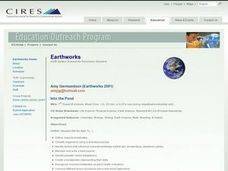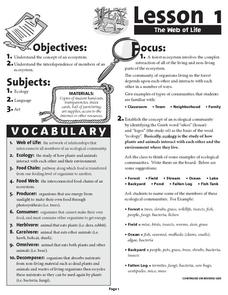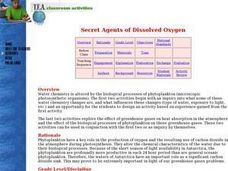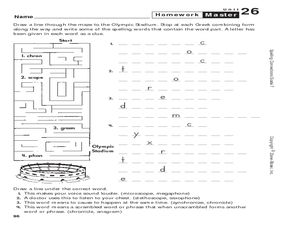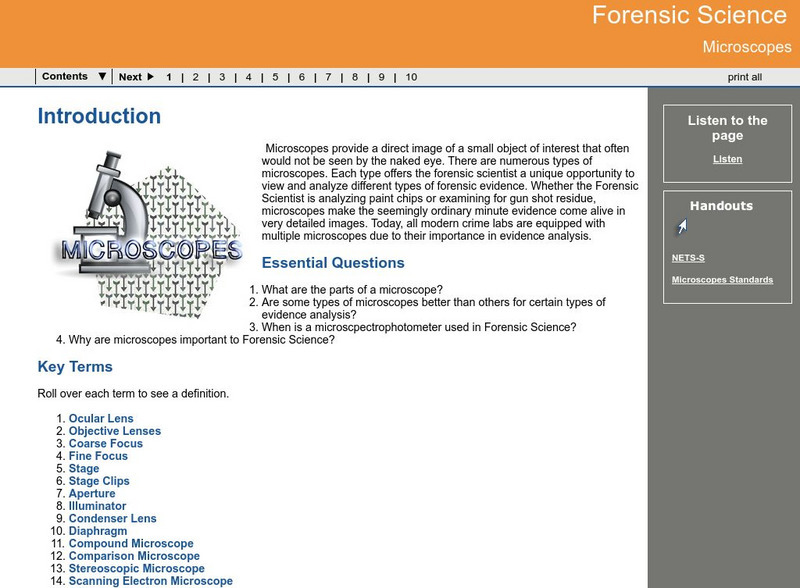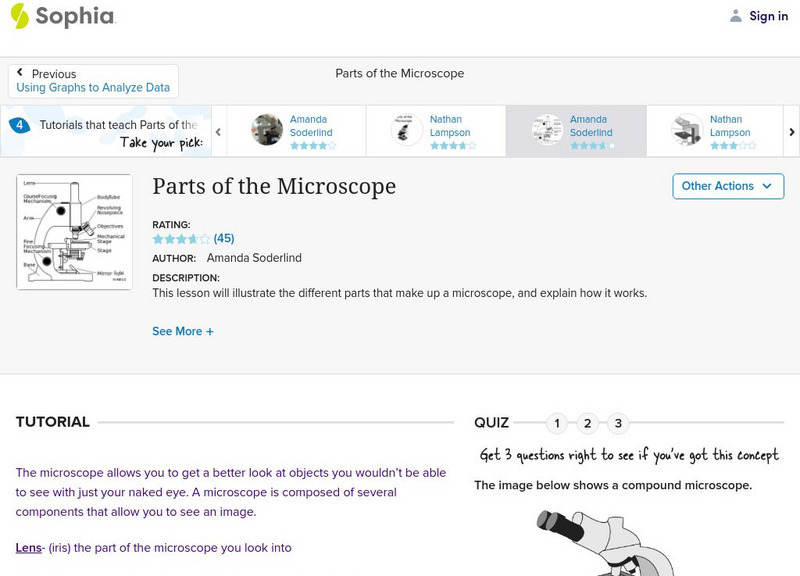Curated OER
Into the Pond
Seventh graders use a pond to explore macroinvertebrates and other organisms. They use a dichotomous key to classify the organisms and maintain a journal recording their findings.
Curated OER
My Favorite Meal
Students investigate ecological systems and the multiple uses of the environment by studying the osprey population.
Curated OER
Stream Chemistry Monitoring
Students become familiar with real-world gathering of chemical data. The experience how the science is done: the nature of analysis, data collection, interpretation, and presentation. They study a nearby body of water for their experiment.
Curated OER
Indoor Air: What's the Matter?
Students develop a greater awareness of the variety and amount of particulate matter in the air. They try to locate general sources of pollution for a specific area and develop some suggestions for improving air quality.
Curated OER
The Web of Life
Young scholars participate in a game in which they discover the balance of life in the ocean. They identify different organisms that rely on different types of food. They answer questions to complete the lesson.
Curated OER
Mineral or Maceral Mosaic
Students study about geologists and their job. They also study that rocks are made up of minerals and organic material by conducting an experiment where they create their own "granite" or "coal".
Curated OER
Using A Winogradsky Column to Analyze Microbial Communities
Pupils use easily obtained materials to study ecological succession in a microbiological community. They collect water samples from outdoor sources in plastic bottles to observe and record changes.
Curated OER
Collect Your Own Drosophila Lab
Students study Drosophila by catching them. They construct catcher-containers to catch Drosophila using fruit as bait. After collection, they examine the flies and collect data to be displayed.
Curated OER
The Effects of Ultraviolet Light on Lumbriculus
Students explore the effects of ultraviolet light on Lumbriculus. They expose ultraviolet light to Lumbriculus (worm) and determine the lethal exposure time. They examine the worm and record their observations.
Curated OER
CSI Clamshell Investigation
Students explore predator/prey relationships. They research information on moon snails and claims. Students draw conclusions from the data collected. They use math and graphing to determine if there is a relationship to the clam's size...
Curated OER
Powdery Mildew Fungi: Classification and Ecology
Pupils use a written key or illustrated key to identify fungi on plant leaves into its genus based on sexual or asexual reproduction, host range diversity, and host-parasite relationships.
Curated OER
Secret Agents of Dissolved Oxygen
Students determine the changes in different types of water in a sealed container over time. They investigate how to measure dissolved oxygen, temperature, and carbon dioxide with calculator or computer probe-ware. Students determine the...
Curated OER
Your Kidneys
In this kidneys worksheet, students review the structure and function of the kidneys in the human body. This worksheet has 18 fill in the blank statements.
Curated OER
Identify the Phases of the Cell
In this cell phases worksheet, 7th graders study the phases of an onion cell. Students write the onion mitosis cell phases on the lines.
Curated OER
Relationships and Biodiversity
Students examine diversity on the planet and the differences within a species. In this investigative lesson students complete a lab that allows students to better understand the relatedness between plants.
Curated OER
Spelling Maze: Greek Roots
In this spelling instructional activity, learners complete a maze to the Olympic Stadium. Students stop at each Greek root and write words with that root. There is no spelling list on this page.
Other
University of Delaware: Virtual Compound Microscope
This virtual microscope is ideal for learning how to properly use a microscope. Users can turn knobs and dials, throw switches, move levers, change lenses, select a specimen, and adjust oculars. Watch the seven minute video for an...
Georgia Department of Education
Ga Virtual Learning: Microscopes and Forensic Science
In this comprehensive interactive tutorial you will learn about the parts of a microscope and how some types of microscopes are better than others for certain types of evidence analysis within the field of Forensic Science. A...
Georgia State University
Georgia State University: Hyper Physics: Microscope
This site from Georgia State University Physics Department provides a discussion of how light refracts through the lenses of a microscope. Demonstrates the parts of a microscope and includes an interactive form in which the magnifying...
Science Struck
Science Struck: A Study of the Microscope and Its Functions
Uses illustrations with labels to complement a detailed examination of the parts and functions of a light microscope and an electron microscope.
Sophia Learning
Sophia: Parts of the Microscope: Lesson 4
This lesson will illustrate the different parts that make up a microscope, and explain how it works. It is 4 of 4 in the series titled "Parts of the Microscope."
Science Struck
Science Struck: Light Microscope vs Electron Microscope: A Comparison
Looks at the differences and similarities between a light microscope and an electron microscope. Discusses their structure, how images are formed, their resolution and magnification, how color is manifested, their portability, cost, and...
Science Struck
Science Struck: Compound Microscope: Basics, Functionality, and Uses
Explains what a compound microscope is, the different parts, how it works, and what it is used for.
PBS
Pbs Learning Media: Microscope Activity
Explore the parts of a compound microscope and view cells through this interactive lesson.
Other popular searches
- Microscope Parts
- Compound Microscope Parts
- Label Microscope Parts
- Microscope Parts Functions
- Identify Microscope Parts
- Biology Lab Microscope Parts
- Microscope Parts Lab
- Microscope Parts and Use
- Microscopes Parts
- Parts of the Microscope Pdf


